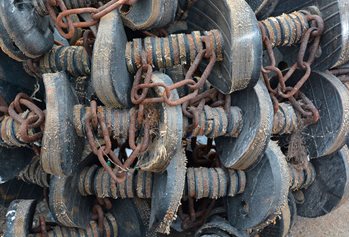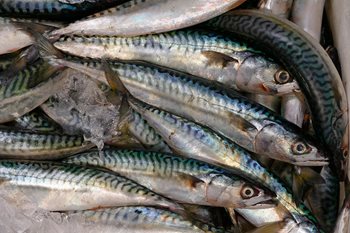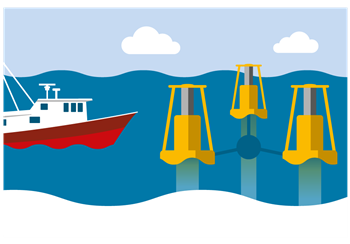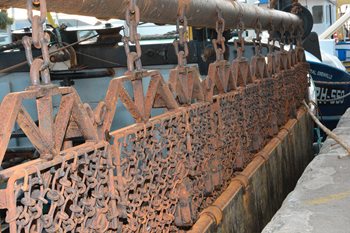 Fishing remains an important UK industry that exploits natural marine ecosystems to provide food and employment, as well as strong cultural identities within the communities upon which it is centred. The Marine Ecosystems Research Programme investigated fish, fisheries and fishing across many of its research threads from better understanding of how fish fit into and control trophic cascades, to modelling the impacts of commercial fishing on target species and the ecosystems in which they live. Investigations into fish-related topics provide excellent examples of how groups of scientists have been assembled within MERP to share expertise and techniques to reach new conclusions and approaches, which not only increase our knowledge base but are also of great utility for a wide range of marine stakeholders.
Fishing remains an important UK industry that exploits natural marine ecosystems to provide food and employment, as well as strong cultural identities within the communities upon which it is centred. The Marine Ecosystems Research Programme investigated fish, fisheries and fishing across many of its research threads from better understanding of how fish fit into and control trophic cascades, to modelling the impacts of commercial fishing on target species and the ecosystems in which they live. Investigations into fish-related topics provide excellent examples of how groups of scientists have been assembled within MERP to share expertise and techniques to reach new conclusions and approaches, which not only increase our knowledge base but are also of great utility for a wide range of marine stakeholders.
Top-down trophic cascades and policy
How and to what extent anthropogenic pressures affect system level responses of ecological communities remains uncertain, and hence a concern for ecosystem managers. Simplistically it is understood that pelagic food webs exhibit what is known as ‘top-down’ trophic cascades; if predators high in the food chain are suppressed, populations of their prey are released to put more pressure on their own prey, so affecting the entire community. How the magnitude of these top-down cascades are controlled and why they appear to be stronger in freshwater then in marine systems is unclear. MERP scientists set out to address these questions in an exercise that synthesised classical food chain theory with pelagic size spectra, the body mass distributions of the individuals that make up pelagic communities. The size spectra often group the biomass into certain body-size classes, known as ‘domes’, interspersed with troughs where some size-classes are under-represented. Taking the best available data and combining it with a mathematical community model, the Species Size-Spectrum Model (SSSM), the researchers suggest that these domes are the result of giant trophic cascades, the domes being amplified by nutrient enrichment, more likely to occur in eutrophic freshwaters than in the oligotrophic, open ocean. However, the frequent observation of domes in pelagic systems implies that trophic cascades of much greater size and impact are more widespread around the globe than thought. When harvesting at each end of the size-spectrum was simulated by removing species from two domes, the effects were noticeably greater from top-down than bottom-up cascades. The conclusion that size-spectrum domes result from top-down cascades is counter to accepted theory which interprets dome formation as cascading bottom-up effect resulting from high food availability. This revelation poses interesting questions and policy implications. For example, it remains unclear to what extent overfishing might, because of feeding interactions, restructure phytoplankton communities and affect ecosystem functions, such as the important carbon sequestration. The work contributes to the greater understanding of ecological processes and systems by making such phenomena available to mathematical modelling and analysis.
Top-down – Bottom up?
 Marine ecosystems are highly complex and dynamic, which can make the analysis and interpretation of traditional indices of ecological structure (e.g. species diversity) very difficult. “Size spectra” based approaches confront such complexity by omitting information on species composition. They focus solely on body size and abundance, which are strongly related to many ecological traits and metabolic processes, so size spectra are an effective ‘ataxonomic’ way of describing the structure and function of ecological communities.
Marine ecosystems are highly complex and dynamic, which can make the analysis and interpretation of traditional indices of ecological structure (e.g. species diversity) very difficult. “Size spectra” based approaches confront such complexity by omitting information on species composition. They focus solely on body size and abundance, which are strongly related to many ecological traits and metabolic processes, so size spectra are an effective ‘ataxonomic’ way of describing the structure and function of ecological communities.
MERP research cruises in the Celtic Sea provided the opportunity to investigate the effects of fishing and primary production on the size spectra of benthic communities from meiofauna, small organisms between 45 μm and 1 mm, to large organisms living close to the seabed (demersal). The results show that fishing by bottom trawling pressure has greater impact on the size spectra of benthic systems in areas of high primary production. The researchers found that primary productivity had a significant effect on size spectra, but only in areas of low fishing pressure, and predators had a higher size spectra than detrivores, suggesting that detrivores have access to less energy, unable to support larger body sizes. They also found that seasonality had strong effects on all these relationships. This work contributes to understanding how regulation of key ecosystem services such as food production by marine food webs are affected by ‘top down’ (predation) and ‘bottom up’ (resource) driven cascades and functional diversity at different levels.
The results from the study have the potential to be used as an indicator of fisheries exploitation and to provide insight into management practices. They can be used to project relative changes of GES descriptors such biodiversity, fish stocks, foodwebs and seabed integrity. They are relevant to UK management policy under EU MSFD and OSPAR.
Raiding parties included in StrathE2E
Among the continuing development and refinement of the StrathE2E model there are some more challenging and hence time consuming developments that have been carried out during MERP. One of these is based on the recognition that fish population composition does not remain constant and apart from the usual changes through growth, reproduction and death incoming migrants can have significant impacts on what species are part of the community, however transient they may be. Migrant fish are important in fisheries with the industry gearing up for influxes, which may produce short term bounty for fishers, but can also affect the balance of the ecosystem into which they intrude. The migratory fish model is intended to represent a group of species, like mackerel, which forms one large stock occupying the NE Atlantic region, where part of its distribution spills into the shelf when it forms the UK’s most valuable fishery. The model treats the mackerel that visit as a ‘raiding party’ which swims in and impacts the shelf ecosystem, some get caught, and the survivors swim away until the raid again, a year later. This work enhances fisheries models by including an important but previously overlooked phenomenon into models.
Fishing and the diversity spectrum
Fishing tends to target bigger fish and hence will impact the species richness in marine communities. The diversity spectrum, the distribution of adult body lengths or masses of species in aquatic communities follow ‘laws’ which reflect the natural state where there are many more small than large species. The diversity spectrum, which can show how diversity varies with body mass in marine ecosystems, helps to quantify biodiversity. Current theories show that distribution of community biomass over species sizes and the distribution of species richness over body sizes appear to be causally independent. Good indicators currently in use are the ‘Large Fish Indicator’ and the recently introduced ‘Typical Length’ but there has not been an indicator for the status of the diversity spectrum. MERP research which combines data generated or mobilised by partners, with theoretical and statistical analyses, can now close this gap in assessments of marine communities. This research confirms for the first time some key predictions of the theory of biodiversity in food webs. It is sufficiently accurate to distinguish Regional Seas with impaired diversity spectra from those where the impacts have remained low, the differences are largely explained by fishing pressure. It shows that regional loss of diversity of large species is likely to reflect cumulative impacts of fishing, as well as potentially other pressures over many decades. The work also informs the idea that the ongoing effects of fishing may not be detectable against a baseline which already represents a long-term fishing effect. These findings may be used to predict the impact of potential management solutions, such as reductions in fishing pressure or marine conservation zones, on biodiversity across body-size scales.
New fishing fleet model
STRATHE2E has been limited in the way it can represent fishing fleets, specifying fishing as external ‘driving’ values of harvest rate on each resource group. Now a separate model has been built that reflects the diversity of fishing methods and so is closer to reality. It represents fleets of different fishing gears (eg different types of trawls, long-lines, dredges, pots), each of which has different catching properties. By using a new ‘model management’ scheme, the modellers can now pause STRATHE2E at say annual intervals, for example, to feed data into the fleet model and re-compute adaptive harvest rates, then restart the ecology with the new rates. This new approach facilitates a more flexible way of bringing up-to-date data into a model and paves the way to possibilities for integrating social, economic and ecologic models – a key aim of further MERP work.
Temperatures up, fish down
Overexploitation of fish stocks and the process of ‘fishing down the marine food web’, the gradual decline in sizes and mean trophic levels of fish communities, are impacting the structure and functioning of marine ecosystems. Such changes have been observed in UK and other seas and in recent years an ecosystem approach to fisheries management has become a useful tool to assess the environmental status of marine ecosystems and to test potential fishing management scenarios. However, climate change and rising temperatures are superimposed on ecosystems and also have to be taken into consideration. Using the Ecopath with Ecosim ecosystem model of the West Coast of Scotland, species-specific optimum temperatures and tolerances were included that, in relation to the observed water temperature data, affected species’ consumptions; these in turn affected temporal biomass and catch predictions. Subsequently, the impact of rising temperature under IPCC climate change scenarios, while keeping fishing pressure constant at rates consistent with maximum sustainable yields, was tested. The results showed a higher impact of rising temperature for cold water species such as grey seals, cod, haddock, whiting and herring, which all declined by 2100 under the worst case climate change scenario.
Temperature drives sardines and anchovies
Analysis from research cruises in the SW approaches to examine the environmental drivers of dominant pelagic fish of the Celtic Sea and Western Channel continue. Results, so far, suggest that temperature plays an important role in driving both anchovy and sardine distribution with phytoplankton and frontal features also playing an important role.
MREDs impact or sanctuary?
 As the installation of marine renewable energy devices (MREDs) gains momentum access to the areas set aside for offshore wind, tide or wave ‘farms’ will be altered for some other sea users such as shipping and fishing. The largest impact is likely to be on commercial fishing which might be displaced from traditional fishing grounds, resulting in a reduction in catch per unit effort, in turn leading to potential conflict. Additionally the placement and infrastructure for MREDs is located on the seabed, perhaps affecting benthic organisms which form important food resources for many commercial species. However, MREDs can also lead to the development of artificial reefs and create exclusion zones which may provide shelter and sanctuary to fish and other species, increasing abundance and diversity and acting as a reservoir for supplying fish into surrounding waters. Predicting such positive outcomes, which could mitigate the initial impacts of installations on the fishing industry, should prove beneficial in reducing the potential for conflict. MERP modellers tested the utility of the Ecopath with Ecosim (EwE) and Ecospace modelling software to address these artificial reef and exclusion zone effects. They developed two case studies, one at shelf scale for the whole of Scotland’s west coast and a second at a single installation scale, both scales of interest to stakeholders involved in the fishing and the MREDs industries, as well as those that make decisions about size and positioning of MREDs. The modellers found that Ecospace could potentially predict artificial reef and exclusion effects, but highlighted that current data availability, spatial scale and resolution issues prevented being able to definitively state whether ecosystem effects would mitigate loss of access to fishing. The scientists, however, are confident that ongoing developments and enhanced data to populate the model would make it appropriate for addressing questions about the spatial effects of MREDs in the future.
As the installation of marine renewable energy devices (MREDs) gains momentum access to the areas set aside for offshore wind, tide or wave ‘farms’ will be altered for some other sea users such as shipping and fishing. The largest impact is likely to be on commercial fishing which might be displaced from traditional fishing grounds, resulting in a reduction in catch per unit effort, in turn leading to potential conflict. Additionally the placement and infrastructure for MREDs is located on the seabed, perhaps affecting benthic organisms which form important food resources for many commercial species. However, MREDs can also lead to the development of artificial reefs and create exclusion zones which may provide shelter and sanctuary to fish and other species, increasing abundance and diversity and acting as a reservoir for supplying fish into surrounding waters. Predicting such positive outcomes, which could mitigate the initial impacts of installations on the fishing industry, should prove beneficial in reducing the potential for conflict. MERP modellers tested the utility of the Ecopath with Ecosim (EwE) and Ecospace modelling software to address these artificial reef and exclusion zone effects. They developed two case studies, one at shelf scale for the whole of Scotland’s west coast and a second at a single installation scale, both scales of interest to stakeholders involved in the fishing and the MREDs industries, as well as those that make decisions about size and positioning of MREDs. The modellers found that Ecospace could potentially predict artificial reef and exclusion effects, but highlighted that current data availability, spatial scale and resolution issues prevented being able to definitively state whether ecosystem effects would mitigate loss of access to fishing. The scientists, however, are confident that ongoing developments and enhanced data to populate the model would make it appropriate for addressing questions about the spatial effects of MREDs in the future.
Sequence database for L4
There is still much to learn about, even our own coastal seas. Much has remained hidden that could inform careful use of this finite resource into the future. It is a main aim of MERP to fill such gaps to inform management and policy formulation. Across the breadth of MERP activities, new technologies and approaches have been harnessed to shrink the knowledge gaps. Investigating the positions and functions of marine organisms and their trophic relationships in the complex environment of the sea is very difficult. Closing the knowledge gap would pay huge dividends in the form of increased knowledge that would inform how the ocean and its fish, in particular, may be impacted by human activities, directly through such things as fishing and indirectly by climate and other anthropogenically-driven changes. Next-generation sequencing is one such development that can reveal previously unknown species and previously unrecognised relationships between prey and predators. During MERP research cruises at L4, off Plymouth, the opportunity was taken to collect samples to develop a reference sequence database of common local fish species. This has allowed for the correct taxonomic annotation of unknown, amplicon barcodes to local species, something that previously had been lacking. The dataset of DNA barcode sequences will be available at NCBI GenBank and BODC, and so will be widely available to researchers and fisheries bodies who wish to use the sequences to identify English Channel species. This technique is of use in identifying unknown species but has already been used in MERP to disentangle the relationship between fish and jellyfish, and so is of interest to modellers.
Fishing disturbance, benthic communities and sustainability
 The direct physical impact on seabed life is well understood, but so far no studies had defined thresholds to inform an ecosystembased approach to managing fishing impacts. In short – how much disturbance can the seabed take and still recover? MERP scientists undertook a large-scale experiment (the largest of its kind, to date) that created a controlled gradient of scallop dredging intensities at sites within a 110km area located offshore in Cardigan Bay, Wales, to assess immediate impacts and short-term recovery of benthic communities and habitat characteristics. Approximately 1,100 hours of fishing, equating to 12,000 dredge-hours, were undertaken by commercial scallop dredgers who collected 30 tonnes of scallop meat. Three scientific cruises took place, one directly prior to commencement of scallop fishing, one directly post-fishing and a final survey four months post-fishing. Responses to fishing varied at different thresholds and were taxon-specific. The lowest threshold of lasting, significant impact occurred between 1 and 3 times fished, reflecting abundance decreases of 39%-70% for some sessile organisms such as cnidarians and bryozoans that live on the seabed surface. Contrastingly scavengers of the seabed such as echinoderms and crustaceans, showed significant increases of two to fourfold in areas fished twice or more. Overall though, the benthic community structure, biomass and abundance at the population level appeared resilient to fishing. What became apparent was that natural temporal variation in community metrics actually exceeded the effects of fishing in this highly dynamic area, and the scientists calculate that matching the natural variation would require an acute level of disturbance as would result from fishing over six times. Vessel and fishing gear monitoring systems mean that the amount of seabed disturbance, in real time, can be ascertained so enabling management systems to be operated, and can be considered a move towards best practice for towed-bottom gear fisheries.
The direct physical impact on seabed life is well understood, but so far no studies had defined thresholds to inform an ecosystembased approach to managing fishing impacts. In short – how much disturbance can the seabed take and still recover? MERP scientists undertook a large-scale experiment (the largest of its kind, to date) that created a controlled gradient of scallop dredging intensities at sites within a 110km area located offshore in Cardigan Bay, Wales, to assess immediate impacts and short-term recovery of benthic communities and habitat characteristics. Approximately 1,100 hours of fishing, equating to 12,000 dredge-hours, were undertaken by commercial scallop dredgers who collected 30 tonnes of scallop meat. Three scientific cruises took place, one directly prior to commencement of scallop fishing, one directly post-fishing and a final survey four months post-fishing. Responses to fishing varied at different thresholds and were taxon-specific. The lowest threshold of lasting, significant impact occurred between 1 and 3 times fished, reflecting abundance decreases of 39%-70% for some sessile organisms such as cnidarians and bryozoans that live on the seabed surface. Contrastingly scavengers of the seabed such as echinoderms and crustaceans, showed significant increases of two to fourfold in areas fished twice or more. Overall though, the benthic community structure, biomass and abundance at the population level appeared resilient to fishing. What became apparent was that natural temporal variation in community metrics actually exceeded the effects of fishing in this highly dynamic area, and the scientists calculate that matching the natural variation would require an acute level of disturbance as would result from fishing over six times. Vessel and fishing gear monitoring systems mean that the amount of seabed disturbance, in real time, can be ascertained so enabling management systems to be operated, and can be considered a move towards best practice for towed-bottom gear fisheries.